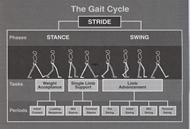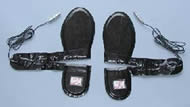The iGait: Providing Motivational Feedback for Gait Improvement
Roseanne Warren, Nydia Cardenas, Whitney King, Obinna Emenike
Department of Mechanical Engineering, Stanford University
ABSTRACT
A common condition in children with Cerebral Palsy (CP) is toe-walking characterized by a lack of heel contact during the stance phase of the gait cycle. With practice, feedback, and sufficient motivation, it is possible for children with CP to achieve a heel-strike while walking. The “iGait” is an innovative device designed to provide two types of audio feedback to users on their foot contact pattern. In real-time feedback mode, the iGait plays two distinct tones for heel and toe contact, alerting users to their style of gait. In period-feedback mode, users can connect an iPod or similar music-playing device to the iGait. Their music will play continuously if they achieve a specified percentage of heel-toe contact patterns. In addition to improving the gait cycle of children with CP, the iGait can also help stroke patients when connected to a surface electromyography (EMG) sensor on the tibialis anterior.
KEYWORDS
Cerebral Palsy, gait, motivation, feedback
INTRODUCTION
The gait cycle of human walking is composed of stance and swing phases (Figure 1) (1). Toe-walking results when a person fails to make heel contact at the beginning of the stance phase and is a common effect of CP. Without heel contact, CP patients are unable to effectively execute the gait cycle. As a result, their walking style is energy intensive and they generally walk less than their peers. Additional consequences of prolonged toe-walking include further weakening of the TA and a risk of future biomechanical complications in the hip and knee joints (2).
With a concentrated effort, most children with CP could make heel contact during the stance phase (2). But lacking constant feedback on their gait pattern as well as the motivation to change, most continue toe-walking. Strengthening of the TA and the development of proper gait are goals that can be reached only through continuous training. A device is needed to motivate children with CP to practice walking with heel contact and the proper gait cycle.
OBJECTIVES
- Design and manufacture a device capable of providing real-time feedback of foot contact patterns for users while walking.
- Motivate users to continuously practice heel contact while walking through positive and enjoyable reinforcement.
- Target a wide range of walking abilities by incorporating various difficulty levels.
- iEnsure that the product is lightweight, portable, and comfortable to wear.
- Allow for independent, home-use capabilities with an easily understood user- interface.
- Encourage users to operate the device in public with a visibly and audibly discrete design.
- Minimize device cost (target total cost of less than $200).
METHOD OF APPROACH
When designing a product to be used while walking, audio feedback is preferable to visual feedback to ensure user safety. As part of a senior design project at Duke University, students Cote, Musgrave, and Schmidt connected a pedometer to a microcontroller and an MP3 player to create a “Walking Motivator” for a child with CP (3). The device does not address issues of improper gait, but simply encourages the user to continue walking. At Stanford University’s Motion and Gait Analysis Lab, B&L Engineering Footswitches are used to diagnose gait disorders in children. Here the motivational and gait analysis capabilities of these two devices are combined to create the “iGait”, a product that encourages CP users to improve their gait cycle through practice. The following sections describe the three main components of the iGait: the B&L Footswitches, user interface, and feedback systems.
Footswitches
B&L Footswitches are shoe inserts containing pressure switches at the toe, first and fifth metatarsals, and heel (Figure 2). When the switches are activated by three to five pounds of force, a voltage matching that of the common line is produced in the output line of activated switch. During diagnostic tests at the Motion & Gait Analysis Lab, wires connect the Footswitches to a relatively heavy box that the child must carry, with the box then wired to a desktop computer. B&L Footswitches are available in a variety of child and adult sizes for $195 a pair (4).
Interface
In the iGait device, voltage signals from the Footswitches are connected to a central interface. The iGait uses the Parallax BASIC Stamp Discovery Kit with a BASIC Stamp 2 (BS2) microcontroller and built-in programming board for its interface. The BS2 processes voltage signals from the Footswitches and produces sound through either a speaker on the programming board or connected headphones (Figure 3). Toggle switches allow the user to turn the iGait on and off, as well as adjust the gait feedback difficulty setting. In addition, the user has the option of plugging their iPod into the iGait interface when operating in the “period feedback” mode (see “Feedback” section).
Feedback
 Figure 3 iGait interface (Click for larger view)
Figure 3 iGait interface (Click for larger view) Users can operate the iGait in one of two different feedback modes: real-time or periodic. Real-time feedback, the default mode, is designed for users who are actively working to improve their gait and want immediate feedback on their foot contact pattern. The device plays two distinct tones upon heel and toe contact. Listening for a familiar heel-toe sequence of tones enables the user to concentrate on achieving a heel-strike, and lets them know when they’ve missed contact.
The periodic feedback is designed for people who would like general reminders to make heel contact while walking, but do not necessarily want to know their foot contact pattern with every step. Activating the periodic feedback mode requires connecting an iPod or similar music playing device to the iGait interface. Music will play continuously as long as the user is achieving heel contact over a certain percentage of their steps. Three difficulty levels (easy, medium, and hard) control the percentage of heel-toe contacts required for music to play.
EXTENSION AND FURTHER APPLICATIONS
Although the iGait was designed principally for children with CP who toe-walk, with some modifications the device could also be useful to many adult stroke patients. For many stroke patients, it is impossible to make heel contact while walking because they cannot bring their foot to a neutral position (0o dorsiflexion) (2). These people can still improve their gait by strengthening the TA muscle. By connecting the iGait to a surface electromyography (EMG) sensor on the TA, users will receive feedback and encouragement to use their TA.
For both CP and stroke users, it would be beneficial for the iGait to collect and store data on foot contact patterns during a walking session. Enabling physicians and therapists to download gait information for their patients could help them track progress and evaluate treatment options. A final extension to the iGait project is adding wireless capabilities. Eliminating wires connecting the Footswitches to the iGait interface would make the device easier to wear and take on and off.
CONCLUSION
The iGait is a device designed to motivate and provide feedback for children with CP to improve their gait cycle. Real-time audio feedback in the form of a sequence of distinct tones alerts users to their foot contact patterns, encouraging them to achieve a heel strike during the stance phase. Periodic feedback is available to users who connect a music-playing device to the iGait, which will play continuously only if regular heel-toe contact is maintained. When connected to a TA surface EMG, the iGait will not only benefit children with CP, but also adult stroke patients.
REFERENCES
- Rose, J., & Gamble, J. G. (2006). Human Walking (3rd ed). Philadelphia: Lippincott Williams & Wilkins.
- J. Rose (personal communication. April 10, 2008).
- Cote, M., Musgrave, T., Schmidt, A. (2006). Walking Motivator. In NSF 2006 Engineering Senior Design Projects to Aid Persons with Disabilities (pp. 80-81). Connecticut: Creative Learning Press, Inc.
- B&L Engineering (n.d.).. Footswitches. [WWW page]. URL http://www.bleng.com/fsw.htm
ACKNOWLEDGMENTS
The authors would like to thank Dr. Jessica Rose, director of the Motion & Gait Analysis Lab at Stanford University for her direction and guidance. We are also grateful to David L. Jaffe, Melody Wu, and Matt Ohline for their coaching and support.
AUTHOR CONTACT INFORMATION
Roseanne Warren
rhwarren@stanford.edu
650-276-1420.
PO Box 14090
Stanford CA
94309

